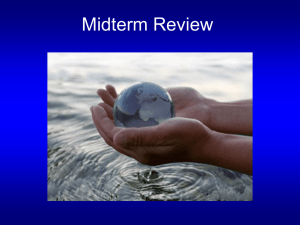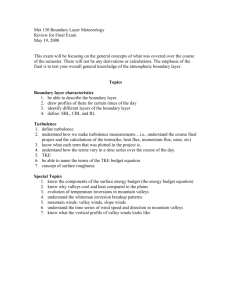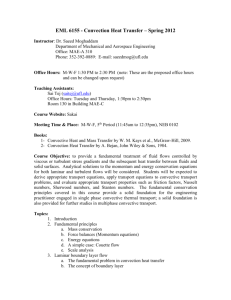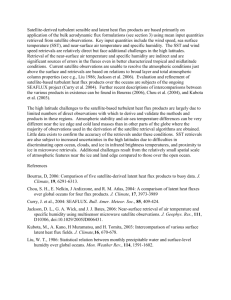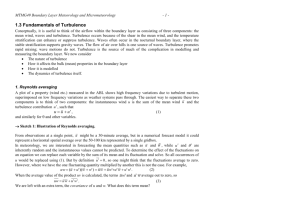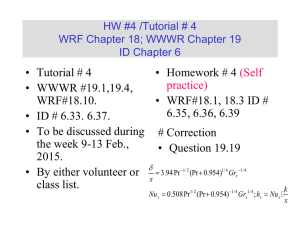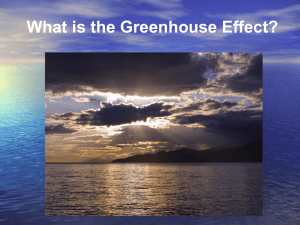Midterm Review
advertisement
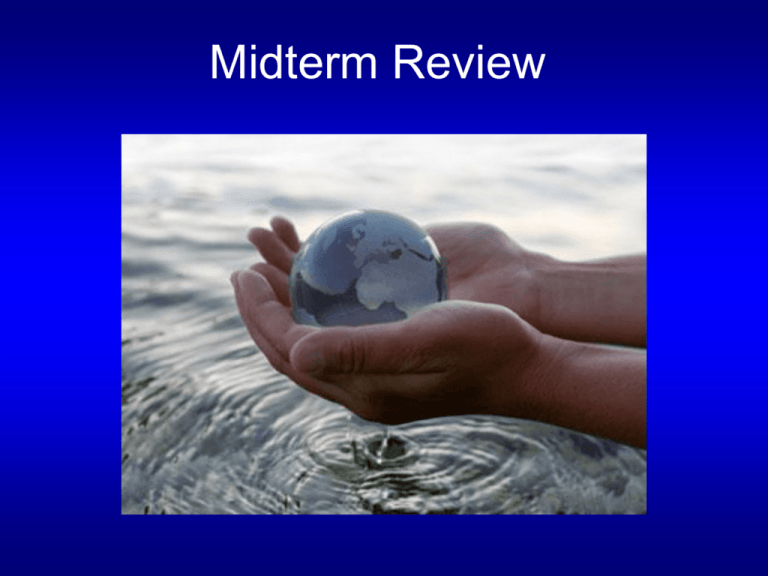
Midterm Review What have we discussed? • • • • • • Importance of the atmospheric boundary layer Surface energy balance Surface water balance Vertical structure of the ABL Modeling the ABL Boundary layer of shallow clouds and deep convection • Effects of different surface types and human activities • Boundary layer processes in global climate models Importance of the ABL • The mission of meteorology is to understand and predict weatherrelated disasters (e.g. tornados, hurricanes, winter storms) and climate-related disasters (e.g. El Nino and global warming). • The modern climatology (meteorology) was born in the 1940s (a very young science!), but has been growing very fast! Now we have a global observational network with many satellites, ships, radars and surface stations, as well as very comprehensive prediction models running on the world’s fastest supercomputers. • The current status of weather and climate predictions: (1) weather prediction good to 10 days, (2) tropical cyclone prediction good in track but not in intensity, (3) climate prediction good to two seasons, (4) climate change projections have a 3-fold difference in magnitude. • The main reasons of the difficulties: (1) Teleconnection problem, (2) Feedback problem, and (3) Subgrid-scale problem. • Importance of the ABL: (1) interface between atmosphere and ocean/land/ice - flux transfer and feedback, (2) the human beings are living in the ABL and change the environment, (3) a basic subgridscale process Surface energy balance – – – – – – – – What is energy? 3 methods of energy transfer The names of the 6 wavelength categories in the electromagnetic radiation spectrum. The wavelength range of Sun (shortwave) and Earth (longwave) radition Earth’s energy balance at the top of the atmosphere. Incoming shortwave = Reflected Shortwave + Emitted longwave Earth’s energy balance at the surface. Incoming shortwave + Incoming longwave = Reflected shortwave + Emitted longwave + Latent heat flux + Sensible heat flux + Subsurface conduction What is sensible heat flux? What is latent heat flux? Bowen ratio B= SH/LH = Cp(Tsurface - Tair) / L(qsurface - qair) provides a simple way for estimating SH and LH when the net radiative flux Fr is available LH=Fr/(B+1), SH=Fr B/(B+1) Factors affecting soil thermal conductivity Other heat sources: precipitation, biochemical, anthropogenic Summary: Surface energy balance Incoming shortwave + Incoming longwave = Reflected shortwave + Emitted longwave + Latent heat flux + Sensible heat flux + Subsurface conduction SWdn =Scos SWup =SWdn LWdn LWup =Tair4 =Ts4 LH=CdLV(qsurface- qair) SH=CdCpV(TsurfaceTair) dT/dt Fc = - dT/dz Methods of Energy Transfer • Conduction – Molecule to molecule transfer – Heat flow: warm to cold – e.g. leather seats in a car • Convection – transferred by vertical movement – physical mixing – e.g. boiling water • Radiation – propagated without medium (i.e. vacuum) – solar radiation provides nearly all energy – The rest of this chapter deals with radiation The Electromagnetic Spectrum The limitations of the human eye! Earth’s energy budget (averaged over the whole globe and over a long time) Yellow: shortwave Red: longwave Sensible heat 7% Net Longwave 21% Latent heat 23% • • At the top of the atmosphere: Incoming shortwave = Reflected Shortwave + Emitted longwave At the surface: Incoming shortwave + Incoming longwave = Reflected shortwave + Emitted longwave + Latent heat flux + Sensible heat flux + Subsurface conduction Sensible Heat • Heat energy which is readily detected • Magnitude is related to an object’s specific heat – The amount of energy needed to change the temperature of an object a particular amount in J/kg/K • Related to mass – Higher mass requires more energy for heating • Sensible heat transfer occurs from warmer to cooler areas (i.e., from ground upward) Latent Heat • Energy required to induce changes of state in a substance • In atmospheric processes, invariably involves water • When water is present, latent heat of evaporation redirects some energy which would be used for sensible heat – Wet environments are cooler relative to their insolation amounts • Latent heat of evaporation is stored in water vapor – Released as latent heat of condensation when that change of state is induced • Latent heat transfer occurs from regions of wetter-to-drier Surface water balance • Global water cycle • Surface water balance • Soil moisture • Palmer drought severity index • Desertification The global water cycle Components of global water cycle • Ocean water • Land soil moisture, rivers, snow cover, ice sheet and glaciers • Sea ice • Atmosphere water vapor, clouds, precipitation • Water in biosphere (including human beings) Surface water balance The changing rate of soil moisture S dS/dt = P - E - Rs - Rg + I Precipitation (P) Evaportranspiration (E=Eb+Ei+Es+TR) Irrigation (I) Runoff (Rs) dS/dt (PDSI, desertification) Infiltration (Rg) Soil moisture • Typically expressed as ‘volumetric soil water content’ S = Vwater / Vsoil • Increases with depth • Complicated to measure Root zone Intermediate zone Ground water Palmer drought severity index (PDSI) • was developed by Wayne Palmer in the 1960s and uses temperature and rainfall information in a model to determine dryness of soil moisture. • is most effective in determining long term drought (a matter of several months) and is not as good with short-term forecasts (a matter of weeks). • It uses a 0 as normal, and drought is shown in terms of minus numbers; for example, minus 2 is moderate drought, minus 3 is severe drought, and minus 4 is extreme drought. Global desertification vulnerability ~1 billion people are under threat Vertical structure of the ABL • Vertical structure of the atmosphere and definition of the boundary layer • Vertical structure of the boundary layer • Definition of turbulence and forcings generating turbulence • Static stability and vertical profile of virtual potential temperature: 3 cases • Boundary layer over ocean • Boundary layer over land: diurnal variation Vertical Structure of the Atmosphere • • Definition of the boundary layer: "that part of the troposphere that is directly influenced by the presence of the earth's surface and responds to surface forcings with a time scale of about an hour or less.” Scale: variable, typically between 100 m - 3 km deep Vertical structure of the boundary layer From bottom up: • Interfacial layer (0-1 cm): molecular transport, no turbulence • Surface layer (0-100 m): strong gradient, very vigorous turbulence • Mixed layer (100 m - 1 km): well-mixed, vigorous turbulence • Entrainment layer: inversion, intermittent turbulence Turbulence inside the boundary layer Definition of Turbulence: The apparent chaotic nature of many flows, which is manifested in the form of irregular, almost random fluctuations in velocity, temperature and scalar concentrations around their mean values in time and space. Generation of turbulence in the boundary layer: Hydrodynamic instability “Hydrodynamically unstable” means that any small perturbation would grow rapidly to large perturbation • Shear instability: caused by change of mean wind in space (i.e. mechanical forcing) • Convective instability: caused by change of mean temperature in the vertical direction (i.e. thermal forcing) Static Stability • Static stability – refers to atmosphere’s susceptibility to being displaced • Stability related to buoyancy function of temperature • The rate of cooling of a parcel relative to its surrounds determines its ‘stability’ of a parcel • For dry air (with no clouds), an easy way to determine its stability is to look at the vertical profile of virtual potential temperature v = (1 + 0.61 r ) Where = T (P0/P)0.286 is the potential temperature r is the water vapor mixing ratio Three cases: (1) Stable (sub-adiabatic): v increases w/ height (2) Neutral (adiabatic): v keeps constant w/ height (3) Unstable (super-adiabatic): v decreases w/ height Stable or sub-adiabatic Neutral or adiabatic Unstable or super-adiabatic Diurnal variation of boundary layer over land • Daytime convective mixed layer + clouds (sometimes) • Nocturnal stable boundary layer + residual layer (leftover of daytime convective mixed layer) Boundary layer over land: Comparison between day and night Strongly stable lapse rate Nearly adiabatic Super-adiabatic Kaimal and Finnigan 1994 Weakly stable lapse rate Nearly adiabatic Strongly stable lapse rate • Subtle difference between convective mixed layer and residual layer: Turbulence is more vigorous in the former Modeling the ABL • Reynolds averaging: Separation of mean and turbulent components u = U + u’, < u’ > = 0 • Intensity of turbulence: turbulent kinetic energy (TKE) TKE = ‹ u’ 2 + v’ 2 + w’ 2 › /2 • Eddy fluxes Fx = - <u’w’>/z • The turbulent closure problem: Number of unknowns > Number of equations • Surface layer: related to gradient • Mixed layer: Local theories (K-theory): < w’a’ >= - Ka dA/dz always down-gradient Non-local theories: organized eddies filling the entire BL, could be counter-gradient Reynolds averaging (1) Separate mean and turbulent components Assume you are given a time series of zonal wind speed u for a period of one hour, the zonal wind speed can be decomposed into two components: u = U + u’ where U = < u > is the time average (< > means time average, over one hour here) and is called the time mean component, while u’ is the fluctuation around U, i.e. u’ = u - U and is called the turbulent component. (2) Do time average <U>=U < u’ > = 0 < A u’ > = A < u’ > = 0 Only cross terms <a’b’> are left. They are also called non-linear terms. Intensity of turbulence: Turbulent kinetic energy (TKE) Mean kinetic energy MKE = (U2 + V2 + W2)/2 Turbulent kinetic energy TKE = ‹ u’ 2 + v’ 2 + w’ 2 › /2 ‹› Time evolution (diurnal) represents time average Vertical profile Eddy fluxes Away from the regions with horizontal inhomogeneities (e.g. shoreline, towns, forest edges), the horizontal eddy fluxes are generally much smaller than the vertical eddy fluxes, and can be neglected: DU/Dt +u’<u’u’>/x +<v’u’>/y +<w’u’>/z = - -1 P/x + fV Then we have: DU/Dt = - -1 P/x + fV -<w’u’>/z = Fx (force due to turbulent fluxes) <u’w’> is called the eddy zonal momentum flux Derivation is similar for the eddy meridional momentum flux <v’w’>, eddy heat flux <h’w’>, and eddy moisture flux <q’w’> The turbulence closure problem • For large-scale atmospheric circulation, we have six fundamental equations (conservation of mass, momentum, heat and water vapor) and six unknowns (p, u, v, w, T, q). So we can solve the equations to get the unknowns. • When considering turbulent motions, we have five more unknowns (eddy fluxes of u, v, w, T, q) • We have fewer fundamental equations than unknowns when dealing with turbulent motions. The search for additional laws to match the number of equations with the number of unknowns is commonly labeled the turbulence closure problem. Surface layer Eddy flux is assumed to be proportional to the vertical gradience of the mean state variable • Sensible heat flux <w’h’> = Qh = Cd Cp V (Tsurface - Tair) • Latent heat flux L <w’q’> = Qe = Cd L V (qsurface - qair) Where is the air density, Cd is flux transfer coefficient, Cp is specific heat of air, V is surface wind speed, Tsurface is surface temperature, Tair is air temperature, qsurface is surface specific humidity, qair is surface air specific humidity Mixed layer theory I: Local theories • K-theory: In eddy-diffusivity (often called K-theory) models, the turbulent flux of an adiabatically conserved quantity a (such as θ in the absence of saturation, but not temperature T, which decreases when an air parcel is adiabatically lifted) is related to its gradient: < w’a’ > = - Ka dA/dz • The local effect is always down-gradient (i.e. from high value to low value) • The key question is how to specify Ka in terms of known quantities. Three commonly used approaches: (1) First-order closure (2) 1.5-order closure or TKE closure (3) K-profile Mixed layer theory II: Non-local theories • • • • • Any eddy diffusivity approach will not be entirely accurate if most of the turbulent fluxes are carried by organized eddies filling the entire boundary layer. The non-local effect could be counter-gradient. Consequently, a variety of ‘nonlocal’ schemes which explicitly model the effects of these boundary layer filling eddies in some way have been proposed. A difficulty with this approach is that the structure of the turbulence depends on the BL stability, baroclinicity, history, moist processes, etc., and no nonlocal parameterization proposed to date has comprehensively addressed the effects of all these processes on the large-eddy structure. Nonlocal schemes are most attractive when the vertical structure and turbulent transports in a specific type of boundary layer (i. e. neutral or convective) must be known to high accuracy. Boundary layer of shallow clouds and deep convection • Global distribution and vertical structure of shallow clouds • Global distribution and vertical structure of deep convection. Four components: convective updraft, convective downdraft, mesoscale updraft, mesoscale downdraft • Differences between shallow clouds and deep convection: change of T, q and h in the boundary layer • Self-suppression processes in deep convection: Overly stabilized state after deep convection • Problems in current global climate models: lack of selfsuppression processes Shallow clouds • Include stratus, stratocumulus and cumulus clouds • Cloud top height generally below 4 km • Sometimes associated with light rain, sometimes not Global distribution of shallow clouds Klein and Hartman, 1993 • Do we notice any patterns? Vertical structure of shallow clouds • Intense longwave radiative cooling at cloud top drives eddies in BL • Eddies pick up moisture and maintain cloud • Eddies also entrain warm, dry air from above the inversion • Entrainment lifts the cloud, subsidence lowers it Bretherton et al. 2004 Deep convection • Cloud top height above 9 km • Generally associated with rain • Sometimes organized into mesoscale convective systems Global distribution of deep convection Vertical structure of deep convection: Four components High θe Convective updrafts (controlled by lower troposphere moisture) Mesoscale updrafts Low θe Mesoscale downdrafts High θe Convective downdrafts Zipser (1977), modified by Houze (1993) Difference in boundary layer between shallow convection and deep convection Shallow convection: boundary layer is well-defined. Deep convection: boundary layer is destroyed by penetrating convective downdrafts, not welldefined (From Barnes 1982) Differences in boundary layer between shallow convection and deep convection Shallow: T decreases Deep: T decreases Shallow: q increases Deep: q decreases Shallow: h keeps const Deep: h decreases (From Barnes 1982) Self-suppression processes in deep convection Missing physics III, IV High θe Convective updrafts (controlled by lower troposphere temperature and moisture) Mesoscale updrafts Low θe Missing physics II Mesoscale downdrafts High θe Convective downdrafts Missing physics I Zipser (1977), modified by Houze (1993) Effects of different surface types and human activities • Effects of different surface types: desert, city, grassland, forest, sea. Deeper heat/water reservoir, decreased Bowen ratio, thinner BL and enhanced convective instability. • Effects of vegetation: (1) makes heat/water reservoir deeper, (2) enhance evaporation, (3) grows and dies in response to environmental conditions • Heat island effect. 7 causes • Dispersion of air pollution. Dependence on stability (name of 3 types) and inversion (name of 2 types) • Global carbon cycle and water cycle: linking the world together. Therefore we need to protect the environment because it is part of our body Effects of different surface types BL depth decreases Convective instability increases Deeper heat reservoir (smaller T change) Deeper water reservoir (Wetter surface) Bowen ratio decreases (More LH contribution) Effects of vegetation • Makes water/heat reservoir deeper (transport deep water out of soil) • Enhances evaporation (leafs increase evaporation area) • Dependent on vegetation type Vegetation feedback Vegetation in turn is affected by environmental conditions (e.g. seasons, droughts, global warming) Effects of human activities Human beings are living in the BL and affect the BL in three different ways: • Change land cover (deforestation and afforestation) • Release or cleanse pollutants (aerosols) • Release or cleanse greenhouse gases Local effect I: The heat island effect • Nighttime: City warmer than surrounding rural area • Daytime: City has same air temperature as rural area Causes of the heat island effect • Increased SW absorption caused by canyon geometry (increased area and multiple reflection) • Decreased LW loss caused by canyon geometry • Increased greenhouse effect caused by air pollution • Anthropogenic heat source • Increased sensible heat storage caused by construction materials • Decreased latent heat flux caused by change of surface type • Decrease sensible and latent heat fluxes caused by canyon geometry (reduction of wind speed) “Canyons” between buildings Local effect II: Dispersion of air pollution • Dispersion depends on stability of BL Unstable Neutral Stable • Dispersion also affected by inversions Low level inversion Upper level inversion Global effect: Anything released by human beings will be transported globally by atmospheric circulations and ocean circulations Land surface processes in global climate models • NCAR CCSM 4 components: Atmosphere, ocean, land, sea ice • 4 components of CLM: Biogeophysics, hydrological cycle, biogeochemistry, dynamical vegetation • 5 sub-grid land cover types: Glacier, wetland, vegetated, lake, urban • The CLM reproduces many aspects of the long-term mean, annual cycle, interannual and decadal variations, and trends of streamflow for many large rivers (e.g., the Orinoco, Changjiang, Mississippi, etc.), although substantial biases exist. • Observed soil moisture variations over Illinois and parts of Eurasia are generally simulated well, with the dominant influence coming from precipitation. • The results suggest that the CLM simulations are useful for climate change analysis. Framework of National Center for Atmospheric Research (NCAR) Community Climate System Model (CCSM) Atmosphere (CAM) Land (CLM) Coupler . Ocean (POP) Sea Ice (CSIM) Configuration of the CLM Subgrid Hierarchy The land surface is represented by 5 primary sub-grid land cover types The vegetated portion of a grid cell is further divided into patches of plant functional types, each with its own leaf and stem area index and canopy height. Each subgrid land cover type and PFT patch is a separate column for energy and water calculations. Important • Please remember to bring your calculator to the exam!
